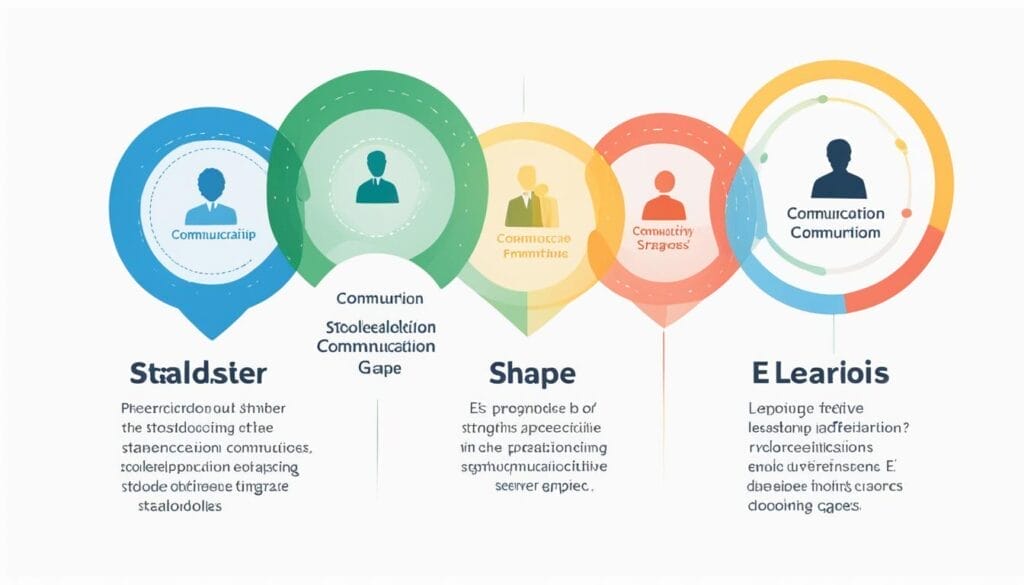Effective leadership communication is crucial for inspiring and driving a team to success. In this article, we will explore strategies that can enhance leadership communication skills, especially in a virtual setting. By improving communication techniques, leaders can effectively convey their vision, motivate their team, and create a collaborative work environment.
Key Takeaways:
- Leadership communication plays a vital role in inspiring trust, motivating teams, and driving positive change.
- Carmine Gallo’s four communication strategies, including clear language, metaphors, humanizing data, and a central mission focus, can help leaders motivate and inspire their teams.
- Authenticity and visibility are important factors in leadership communication, as they build trust and establish a strong leadership presence.
- Active listening and empathy foster open and collaborative environments, allowing leaders to connect with their team members on a deeper level.
- Creating clarity, setting clear expectations, and tailoring communication to different stakeholders are key elements of effective leadership communication.
The Role of Communication in Leadership
Communication plays a crucial role in effective leadership. Leaders who excel in communication can inspire trust, motivate their team, and drive positive change. As a leader, you need to be skilled in various communication styles and adapt your approach to different situations. Effective communication allows you to convey your vision, align efforts towards common goals, and create a positive and collaborative work environment.
Leadership communication involves both verbal and nonverbal cues. It encompasses active listening, empathy, clear articulation, and appropriate body language. By mastering these communication skills for leaders, you can enhance your influence and foster stronger relationships with your team members.
“Good communication does not just happen. It requires sincere effort, active listening, and the ability to connect with others on a deeper level.” – Simon Sinek
The Power of Effective Communication in Leadership
Effective leadership communication creates a sense of trust, enables transparency, and promotes teamwork. By articulating your expectations clearly, providing timely feedback, and engaging in open dialogue, you can foster an environment of collaboration and mutual respect. Strong communication skills also allow you to navigate challenges, resolve conflicts, and inspire your team to achieve their full potential.
Developing Communication Skills for Effective Leadership
Enhancing your communication skills as a leader requires continuous learning and practice. Here are some strategies to consider:
- Active Listening: Pay close attention to your team members, ask thoughtful questions, and show genuine interest in their perspectives.
- Empathy: Put yourself in others’ shoes, understand their emotions and experiences, and respond with empathy.
- Clarity: Express your thoughts and ideas clearly, using concise language and avoiding jargon.
- Adaptability: Tailor your communication style to different individuals and situations, considering their unique needs and preferences.
By developing these communication skills for leaders, you can establish yourself as an effective and influential communicator, driving your team towards success.
| Benefits of Effective Leadership Communication | |
|---|---|
| Improved team collaboration and performance | Increased employee engagement and motivation |
| Enhanced problem-solving and decision-making | Greater transparency and trust within the organization |
| Effective change management | Better alignment of goals and objectives |
By recognizing the importance of communication in leadership and continually honing your communication skills, you can become a more influential leader, driving positive change and creating a supportive work environment.
Four Strategies to Motivate and Inspire Your Team
Carmine Gallo, in his article, outlines four communication strategies that can help leaders motivate and inspire their teams. These strategies include:
- Using clear and concise language to discuss complex ideas
- Employing metaphors to reinforce key concepts
- Humanizing data to create value
- Making the mission a central focus to align teams
By implementing these strategies, leaders can effectively communicate their vision and inspire their team members. Let’s take a closer look at each strategy:
“Using clear and concise language to discuss complex ideas”
Complex ideas can often be challenging to communicate, especially in a fast-paced work environment. However, leaders who can articulate complex ideas in a clear and concise manner can ensure that their team members understand the message clearly. By using simple language, avoiding jargon, and breaking down complex concepts into digestible pieces, leaders can engage their teams and facilitate better understanding.
“Employing metaphors to reinforce key concepts”
Metaphors are powerful tools that can simplify abstract or complex ideas by relating them to familiar concepts. By using metaphors, leaders can make their message more relatable and memorable. Metaphors create visual imagery that helps team members grasp the essence of the message and connect it to their own experiences. This technique can engage the imagination and foster a deeper understanding of the key concepts being communicated.
“Humanizing data to create value”
Data and numbers can often feel detached and overwhelming to team members. As a leader, humanizing data involves telling stories and presenting real-life examples that bring the data to life. By illustrating the impact of the data on individuals or the organization, leaders can help their team members see the value and significance of the information being shared. Humanizing data fosters empathy and encourages team members to actively engage with the insights.
“Making the mission a central focus to align teams”
An inspiring mission provides a sense of purpose and direction for a team. By making the mission a central focus in communication, leaders can create alignment and inspire team members to work towards a common goal. Leaders should consistently communicate how individual efforts contribute to the larger mission and emphasize the importance of each team member’s role. When team members feel connected to a purpose, they are more motivated and engaged in their work.
By incorporating these communication strategies into their leadership style, leaders can motivate and inspire their teams, leading to improved performance and a positive work environment.
Leadership Communication Strategies – Summary
| Communication Strategy | Description |
|---|---|
| Clear and concise language | Using simple and easily understandable language to convey complex ideas, avoiding jargon and providing clarity to ensure understanding among team members. |
| Metaphors | Relating abstract or complex concepts to familiar ideas through metaphors, making the message relatable and memorable for team members. |
| Humanizing data | Presenting data in a way that connects with the audience on an emotional level, using stories and examples to demonstrate the value and impact of the data. |
| Mission focus | Making the organizational mission the central focus of communication, emphasizing how each team member’s role contributes to the overall mission, and creating alignment and a sense of purpose. |
The Importance of Authenticity and Visibility in Leadership Communication
Authenticity and visibility are crucial aspects of leadership communication. As a leader, it is essential to be genuine and true to yourself, avoiding corporate jargon or pretense. By embracing your unique voice and personality, you can establish a deeper connection with your team members.
Authenticity fosters trust and creates a strong leadership presence.
Being accessible and visible to your team members is equally important. When you make yourself available and show genuine interest in their ideas and concerns, you create an open communication channel. This accessibility builds trust and allows team members to feel comfortable approaching you with their thoughts and feedback.
Visibility strengthens leadership presence and encourages open dialogue.
John Maxwell once said, “People don’t care how much you know until they know how much you care.” This sentiment highlights the importance of authenticity and visibility in leadership communication. When team members see that you genuinely care about their success and well-being, they are more engaged and motivated to contribute their best work.
Showcasing authenticity and visibility in your leadership communication requires a conscious effort and mindful approach. Here are some tips to help you embody these qualities:
- Be yourself: Don’t be afraid to show vulnerability and share your personal experiences. This authenticity helps team members relate to you on a deeper level.
- Listen actively: Demonstrate genuine interest by actively listening to your team members. Engage in meaningful conversations and ask follow-up questions to show that their input is valued.
- Be present: When interacting with your team, be fully present in the moment. Avoid distractions and give your undivided attention to the conversation at hand.
- Maintain transparency: Share relevant information openly and honestly. Transparency builds trust and creates a culture of openness within your team.
- Lead by example: Model the behaviors and values you expect from your team members. Show integrity, honesty, and empathy in your actions and words.
By incorporating authenticity and visibility into your leadership communication, you can create a positive and empowering environment where your team members feel heard, valued, and inspired to reach their full potential.
The Power of Active Listening and Empathy in Leadership Communication
Effective leadership communication not only involves speaking, but also listening actively and demonstrating empathy. Leaders who possess these qualities can foster a deeper understanding of their team members, build trust, and create an environment that encourages collaboration. Active listening is a crucial skill that allows leaders to truly hear what others have to say and gain insights into their perspectives and concerns.
When practicing active listening, leaders should focus on the speaker, maintain eye contact, and avoid interrupting or jumping to conclusions. By asking thoughtful questions and engaging in meaningful conversations, leaders demonstrate their genuine interest in understanding their team’s needs and challenges.
“Active listening is not just about hearing the words spoken—it’s about understanding the emotions, values, and motivations behind them.”
An important aspect of effective leadership communication is empathy. Leaders who empathize with their team members can connect on a deeper level and create a supportive and inclusive environment. By putting themselves in others’ shoes and considering their perspectives, leaders can better address their team’s concerns and needs.
Empathy helps leaders build stronger relationships with their team members, fostering trust and loyalty. It allows leaders to respond with compassion and understanding, leading to increased collaboration and a more positive work culture.
The Benefits of Active Listening and Empathy in Leadership Communication
The power of active listening and empathy in leadership communication cannot be underestimated. When leaders actively listen and demonstrate empathy, they:
- Foster Trust: By truly understanding their team members’ concerns and perspectives, leaders build trust and create an environment where open and honest communication thrives.
- Promote Collaboration: Active listening and empathy enable leaders to identify common goals and facilitate collaboration among team members, leading to enhanced productivity and innovation.
- Enhance Problem-Solving: By listening attentively and empathetically, leaders gain valuable insights that help identify solutions to challenges, promote creativity, and drive problem-solving within the team.
The power of active listening and empathy in leadership communication cannot be overstated. By prioritizing these skills, leaders can create a culture of open dialogue, understanding, and trust, allowing their teams to thrive and achieve exceptional results.
Creating Clarity and Setting Clear Expectations in Leadership Communication
Clear and concise communication is fundamental for effective leadership. Leaders need to provide clarity in their messages and ensure that team members understand what needs to be achieved. By setting clear expectations, leaders can reduce confusion, align efforts, and maintain focus on the desired outcomes.
Effective communication of expectations helps in driving performance and keeping everyone on the same page.
When leaders communicate with clarity, they eliminate ambiguity and create a shared understanding among team members. By clearly defining goals and expectations, leaders provide a roadmap for success and enable team members to perform at their best.
One effective way to create clarity is by using examples and illustrations that resonate with the team. This helps team members visualize goals and understand how their contributions align with the overall objectives.
Leaders should also encourage open dialogue and provide opportunities for team members to ask questions and seek clarification.
“When leaders are clear in their communication and set clear expectations, it empowers team members to take ownership of their work and deliver exceptional results.” – Amy Smith, HR Director
Another important aspect of setting clear expectations is ensuring that team members have a clear understanding of their roles and responsibilities. Leaders should communicate the specific tasks, deadlines, and deliverables expected from each team member.
Regularly reviewing and reinforcing these expectations through ongoing communication helps ensure that everyone stays on track and is aware of any changes or updates.
Leadership communication should also include transparency and openness about challenges or hurdles that may affect the team’s progress. By communicating such information, leaders demonstrate a commitment to a transparent work environment and help team members anticipate and navigate potential obstacles.
Lastly, leaders should encourage feedback and be open to addressing concerns or questions raised by team members. This fosters a culture of open communication and collaboration, where team members feel heard and valued.
By creating clarity and setting clear expectations in leadership communication, leaders empower their teams to perform effectively, achieve goals, and contribute to the overall success of the organization.
Tailoring Communication to Different Stakeholders

Leadership communication must be adaptable to different stakeholders in order to effectively convey messages and build relationships. Each stakeholder – whether they are employees, clients, or investors – has unique goals, concerns, and preferences. To ensure effective communication, leaders should tailor their approach to match the needs of specific individuals or groups.
Understanding the personality, motivations, and roles of stakeholders is essential when crafting communication strategies. By doing so, leaders can build rapport and influence stakeholders in a more impactful manner. Tailoring communication allows leaders to address specific concerns, align interests, and ensure messages are received and understood accurately.
When communicating with employees, leaders should emphasize their vision and the benefits it brings to both the organization and individuals. Listening to and addressing employee concerns fosters trust and demonstrates a commitment to their well-being.
When engaging with clients, leaders should highlight how their products or services can help solve challenges and achieve desired outcomes. Understanding client goals and proactively addressing their needs leads to stronger relationships and increased customer satisfaction.
When communicating with investors, leaders should focus on demonstrating transparency and providing timely updates on financial performance, growth strategies, and future plans. By communicating effectively, leaders can instill confidence and attract continued support and investments.
By tailoring communication to different stakeholders, leaders can build stronger connections, align interests, and achieve desired outcomes. Effective communication strategies enable leaders to influence stakeholders, foster collaboration, and ensure the success of their initiatives.
The Role of Transparency in Leadership Communication
Transparency is a key aspect of effective leadership communication. When leaders are open and transparent about the company’s goals, challenges, and opportunities, they foster trust and create an environment where employees feel empowered to contribute their ideas and insights.
Transparent communication not only builds trust but also encourages collaboration among team members. By sharing information openly, leaders provide everyone with a clear understanding of their role in the company’s success and create a sense of shared purpose.
Transparency also helps in addressing concerns and resolving conflicts promptly. When leaders are open about the challenges the organization is facing, they invite their team to participate in finding solutions and demonstrate their willingness to work together.
Transparency is the foundation of trust. Without trust, it’s difficult to establish effective communication channels and build a cohesive and high-performing team. By practicing transparency in leadership communication, leaders create an environment where trust can flourish, fostering a culture of collaboration and open dialogue.
Leaders who prioritize transparency in their communication demonstrate their commitment to honesty, integrity, and ethical behavior. This sets a positive example for the entire organization and encourages employees to embrace transparency in their own interactions.
In summary, transparency is a crucial element of leadership communication. By being open, honest, and transparent, leaders can build trust, foster collaboration, and create a culture of open dialogue and shared accountability.
Developing Strong Body Language and Receiving Feedback in Leadership Communication

Effective leadership communication goes beyond spoken words; it also involves nonverbal cues and body language. Leaders should pay attention to their body language, as it plays a crucial role in conveying interest, warmth, and trust to their team members. Positive body language includes maintaining eye contact, using appropriate gestures, and displaying an open and welcoming posture.
“The human body is the best picture of the human soul.” – Ludwig Wittgenstein
By leveraging strong body language, leaders can create an environment where their team feels heard and valued, fostering effective communication and building strong relationships.
Additionally, leaders should actively seek feedback from their team members. Feedback is an invaluable tool for growth and improvement in leadership communication. By inviting input from others, leaders demonstrate a willingness to listen and consider different perspectives. This not only encourages open dialogue but also fosters a culture of continuous learning and improvement within the team.
- Actively seek feedback from team members
- Consider different perspectives and viewpoints
- Demonstrate a willingness to act on feedback
Receiving and implementing feedback effectively strengthens leadership communication skills and creates a sense of trust and collaboration among team members.
The Power of Feedback
Feedback is a powerful tool that enables leaders to understand how their communication style and approach impact their team members. It provides valuable insights into areas of strength and areas for improvement. By actively listening to feedback and taking appropriate action, leaders can tailor their communication strategies to better meet the needs of their team and improve overall effectiveness.
| Benefits of Receiving Feedback in Leadership Communication | Actions for Leaders |
|---|---|
| Gain insights into strengths and weaknesses | Actively seek feedback from team members |
| Improve self-awareness and self-development | Consider different perspectives and viewpoints |
| Enhance leadership effectiveness | Demonstrate a willingness to act on feedback |
| Build trust and rapport with team members | Implement changes based on feedback |
By embracing feedback and continuously improving their communication skills, leaders can create a positive and inclusive work environment that fosters growth and success.
Conclusion
Effective leadership communication is a critical skill that plays a pivotal role in driving success, especially in a virtual setting. By implementing strategies such as employing clear and concise language, active listening, practicing empathy, and tailoring communication to different stakeholders, leaders can enhance their communication skills and inspire their teams.
Developing strong communication skills is essential for effective leadership, as it fosters a positive and productive work environment. Leaders who excel in communication can create a sense of clarity, alignment, and trust among team members, leading to improved collaboration and performance. Mastering the art of leadership communication unlocks a leader’s full potential and propels their team towards success.
In a virtual interaction, effective leadership communication becomes even more crucial. Leaders must leverage technology to connect with their team members, build relationships, and convey their vision and goals. By adopting the strategies discussed in this article and embracing the challenges and opportunities of virtual interaction, leaders can overcome barriers and ensure effective communication with their teams, regardless of physical distance.
FAQ
Why is effective leadership communication important?
Effective leadership communication is important because it inspires trust, motivates teams, and drives positive change. It allows leaders to convey their vision, align efforts towards common goals, and create a positive and collaborative work environment.
What are some communication strategies that can help leaders motivate and inspire their teams?
Some communication strategies that can help leaders motivate and inspire their teams include using clear and concise language, employing metaphors to reinforce key concepts, humanizing data to create value, and making the mission a central focus to align teams.
How does authenticity and visibility play a role in leadership communication?
Authenticity and visibility are crucial aspects of leadership communication. Being genuine and accessible to team members helps build trust and establishes a strong leadership presence. By showing genuine interest, being present, and making oneself available, leaders foster open communication channels and create a sense of connection with their team.
Why is active listening important in leadership communication?
Active listening is important in leadership communication because it allows leaders to genuinely listen to their team members, ask insightful questions, and engage in meaningful conversations. It fosters trust, creates an open and collaborative environment, and helps leaders gain a better understanding of others’ perspectives.
How can leaders create clarity and set clear expectations in their communication?
Leaders can create clarity and set clear expectations in their communication by providing clarity in their messages, clearly defining goals and expectations, and ensuring that team members understand what needs to be achieved. Clarifying expectations helps reduce confusion, align efforts, and maintain focus on desired outcomes.
How can leaders tailor their communication style to different stakeholders?
Leaders can tailor their communication style to different stakeholders by considering the personality, motivations, and roles of their audience. Understanding the goals, concerns, and preferences of each stakeholder helps in building rapport, influencing effectively, and ensuring that messages are received and understood accurately.
Why is transparency important in leadership communication?
Transparency is important in leadership communication because it builds trust and creates an environment where employees feel empowered to share their ideas and contribute to the organization. Transparent communication fosters collaboration, ensures that everyone understands their role, and encourages a shared sense of purpose.
How can leaders improve their body language and receive feedback to enhance their communication?
Leaders can improve their body language by paying attention to cues such as eye contact, gestures, and posture. Positive body language conveys interest, warmth, and trust. Additionally, leaders should actively seek feedback from their team, consider different perspectives, and demonstrate a willingness to act on feedback. Implementing feedback improves communication skills and strengthens relationships with team members.
Why is effective leadership communication important in a virtual setting?
Effective leadership communication is important in a virtual setting because it allows leaders to enhance their communication skills, inspire their teams, and create a positive and productive work environment. Developing strong communication skills in a virtual setting is essential for effective leadership and maintaining meaningful connections with team members.





